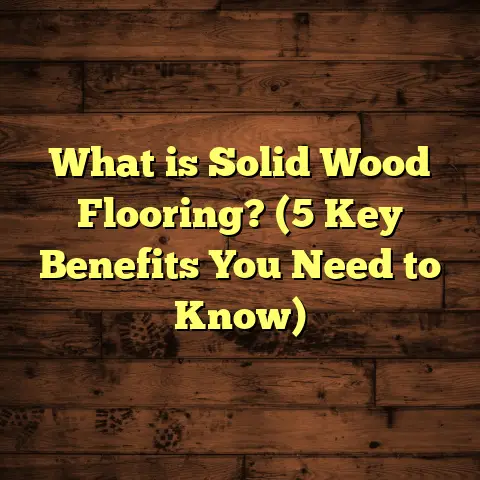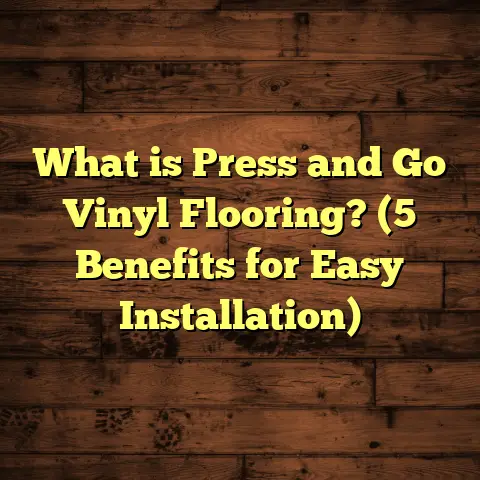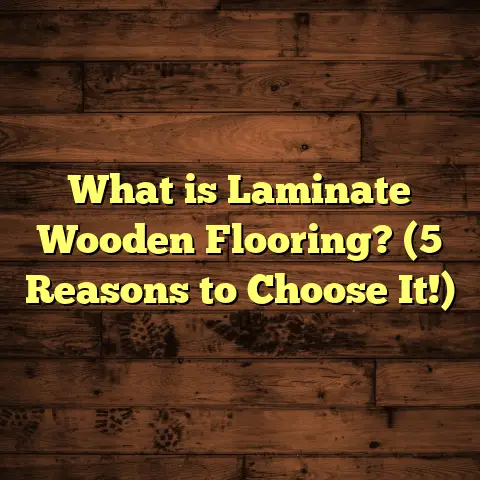What is More Expensive: Epoxy or Ceramic Floor Tiles? (5 Key Factors)
Have you ever stood staring at a shiny epoxy floor and then glanced at a beautiful ceramic tile floor, wondering which one would cost you more? I’ve been there many times. Choosing the right flooring is not just about aesthetics—it’s a big financial decision, especially when you want the best value for your money. So, what is more expensive: epoxy or ceramic floor tiles? I’m going to share everything I’ve learned from years of working on flooring projects, backed by real data, personal stories, and useful tools that help me nail budgets every time.
What Is Epoxy Flooring and Ceramic Floor Tiles?
To start, let’s clarify what epoxy flooring and ceramic tiles actually are, because understanding materials is key to understanding costs.
Epoxy Flooring: What Exactly Is It?
Epoxy flooring is a type of coating applied over concrete floors. It’s made from two main components—a resin and a hardener—that chemically react to form a rigid plastic material. This plastic forms a smooth, durable surface that’s resistant to stains, chemicals, impacts, and heavy foot or vehicle traffic.
I’ve seen epoxy floors in all kinds of settings: industrial warehouses, auto workshops, commercial kitchens, and even in some modern homes. The versatility is impressive. You can have a simple solid color epoxy floor or go fancy with metallic finishes, flakes embedded for texture, or even logos and patterns.
The application process is critical. The concrete base has to be properly prepared by grinding, cleaning, repairing cracks, and sometimes moisture testing before epoxy coats can be applied. This prep work ensures the epoxy adheres well and lasts long.
Ceramic Floor Tiles: What Are They Made Of?
Ceramic tiles are made from natural clay that’s molded into shape and then fired at high temperatures in a kiln. They can be glazed or unglazed. Glazed tiles have a glass-like coating that adds color and protects the surface, while unglazed tiles are more porous but offer better slip resistance.
Ceramic tiles come in all shapes, sizes, colors, and patterns—everything from small mosaics to large-format tiles. They’re common in bathrooms, kitchens, hallways—anywhere moisture resistance and easy cleaning matter.
The installation process involves laying a mortar bed or adhesive on the floor, setting the tiles precisely, grouting the joints between tiles, and sealing the grout for durability.
Material Cost Breakdown
Let’s talk numbers now because this is where most people’s minds go first. When I’m helping clients choose between epoxy and ceramic tiles, material cost is often the first comparison they ask about.
How Much Does Epoxy Material Cost?
Epoxy resin kits usually cost between $3 and $12 per square foot depending on quality and finish. Here’s what influences price:
- Basic epoxy systems: About $3–$5 per square foot. These are single-color solid coats with minimal additives.
- Mid-range epoxy systems: Around $6–$9 per square foot. These might include decorative chips or metallic pigments.
- High-end epoxy: $10–$12 or more per square foot for multiple layers with special effects or UV-resistant coatings.
For example, on one industrial project I managed last year, the client wanted a metallic epoxy finish with three layers for extra durability and aesthetic appeal. We ended up budgeting around $11 per square foot just for materials.
Ceramic Tile Material Costs
Ceramic tile prices vary widely based on size, finish, and origin:
- Basic ceramic tiles: $1–$3 per square foot for mass-produced options.
- Mid-range ceramic: $4–$8 per square foot for designer patterns or mid-quality imported tiles.
- High-end ceramic: $9–$15+ per square foot for designer or artisan tiles from Europe or Asia.
In a residential kitchen I renovated recently, the client chose hand-painted ceramic tiles at about $12 per square foot. The aesthetic was stunning but definitely came with a premium price tag.
Comparing Material Costs
If we compare average mid-range options:
| Flooring Type | Material Cost (per sq ft) |
|---|---|
| Epoxy | $6 – $9 |
| Ceramic Tiles | $4 – $8 |
Material-wise, epoxy generally starts higher than basic ceramic tiles but overlaps with mid-range ceramics depending on style and finish.
Installation Costs: The Hidden Expense
Material price is just one part of the budget puzzle. Installation can sometimes double or even triple your flooring costs if you’re not careful.
What Goes Into Epoxy Installation?
Epoxy installation is a multi-step process that requires skilled labor and plenty of prep:
- Surface preparation: Grinding or shot blasting to roughen the concrete so epoxy adheres well.
- Cleaning: Removing dust, grease, oils.
- Repair: Filling cracks or holes in concrete.
- Moisture testing: Ensuring vapor barriers are intact to prevent bubbling.
- Priming: Applying primer coat to seal concrete pores.
- Epoxy coats: Usually 2-3 layers applied over several hours/days.
- Topcoat: A clear protective layer for UV resistance and gloss.
This process takes time and expertise. Labor costs typically range from $3 to $7 per square foot depending on location and floor condition.
On a commercial garage project I worked on in Chicago, prep took twice as long as expected because the concrete was old and cracked badly. Labor ended up costing about $6 per square foot there.
Ceramic Tile Installation Challenges
Tile installation is labor-intensive:
- Setting up a level base.
- Mixing and applying thin-set mortar or adhesive.
- Cutting tiles to fit corners or obstacles.
- Laying tiles precisely with spacers.
- Grouting joints after tile setting.
- Cleaning excess grout.
- Sealing grout lines to prevent staining.
Tile installers charge between $5 and $15 per square foot depending on tile size, pattern complexity, and region.
In a recent bathroom renovation I oversaw, intricate mosaic tile work pushed labor costs near the top end — about $14 per square foot — due to precision cutting and layout demands.
Installation Cost Comparison Summary
| Flooring Type | Installation Cost (per sq ft) |
|---|---|
| Epoxy | $3 – $7 |
| Ceramic Tiles | $5 – $15 |
Tile installation is often pricier because it requires more detailed labor and time.
Maintenance & Longevity: What Will You Pay Later?
People often forget that flooring isn’t just a one-time expense. How much will it cost you down the road?
Epoxy Floors: Easy Upkeep?
Epoxy floors are practically low-maintenance superheroes:
- Resistant to stains, chemicals, abrasions.
- Easy to clean with mopping or power washing.
- No grout lines to worry about.
- Lasts 10-20 years depending on wear.
- Usually only need re-coating every 5-10 years in high-traffic areas.
A client of mine owns an auto repair shop with epoxy floors installed 15 years ago. They’ve only needed some spot repairs twice—no complete redo yet.
Ceramic Tile Maintenance Realities
Ceramic tile itself is durable but grout lines require attention:
- Grout attracts dirt; needs sealing every 1-3 years.
- Tiles can chip or crack if heavy objects fall on them.
- Repairs might require cutting out damaged tiles and matching replacements.
- Overall lifespan 20+ years if well maintained but initial maintenance can be more demanding than epoxy.
One homeowner I helped had to replace cracked tiles after moving heavy furniture—each tile replacement cost around $50 including labor.
Long-Term Cost Comparison
| Flooring Type | Maintenance Frequency | Typical Costs Over 10 Years |
|---|---|---|
| Epoxy | Recoating every 5-10 years | ~$1-$3 per sq ft for recoating |
| Ceramic Tiles | Grout sealing every 1-3 years + repairs | ~$2-$5 per sq ft (sealing + occasional tile replacement) |
Maintenance costs can add up but epoxy tends to be cheaper over time due to less frequent upkeep needs.
Style & Aesthetic Impact: Design That Matters
Choosing between epoxy and ceramic isn’t just numbers—it’s about how your space feels and looks.
Epoxy’s Modern Look
Epoxy floors give you smooth surfaces with high gloss or matte finishes. You can create:
- Solid colors
- Marble-like swirls with metallic pigments
- Embedded logos or patterns
- Textured surfaces for slip resistance
I installed an epoxy floor for a trendy restaurant last year with a custom black and gold swirl effect—it looked amazing and fit their brand vibe perfectly.
Ceramic’s Timeless Beauty
Ceramic tile offers endless styles:
- Classic subway tiles
- Mediterranean patterns
- Rustic terracotta
- Modern large-format slabs
- Intricate mosaics
If you want traditional charm or upscale elegance, ceramic often wins hands down. A homeowner I worked with chose handmade Spanish ceramic tiles for their entryway—they loved how it gave their home personality and warmth.
Which Adds More Value?
Ceramic tile often has more resale cachet because buyers associate it with luxury finishes. However, epoxy floors appeal in commercial settings or modern homes valuing sleek design.
Environmental Factors & Durability: The Real Test
Where you live impacts your choice too.
Epoxy Floors Perform Well In:
- Industrial environments
- Garages
- Commercial kitchens
- Areas with chemical exposure
They resist oil stains, acids, spills better than most tile surfaces.
Ceramic Tiles Shine In:
- Bathrooms
- Kitchens
- Wet areas needing water resistance
But they can crack if subfloor isn’t stable or temperature fluctuates dramatically.
I once had a client in Minnesota whose ceramic floor cracked during harsh winters due to insufficient insulation underneath—epoxy would have been more forgiving there.
Real Project Case Studies I’ve Been Part Of
To give you even clearer insight, here are detailed examples from my experience:
Project 1: Commercial Garage – Epoxy Floor
- Size: 2,000 sq ft
- Material cost: $8/sq ft (high-quality epoxy)
- Installation cost: $6/sq ft
- Total upfront cost: $28,000
- Maintenance last 10 years: minimal; no major repairs needed
- Client satisfaction: Excellent durability under heavy vehicle traffic
Project 2: Residential Kitchen – Ceramic Tile
- Size: 500 sq ft
- Material cost: $10/sq ft (designer ceramic tile)
- Installation cost: $12/sq ft (complex pattern)
- Total upfront cost: $11,000
- Maintenance over 10 years: grout sealing twice ($400 total), one tile replacement ($150)
- Client satisfaction: Loved the look; budget was tight but worth it for style
These real-world numbers show how total costs shift based on use-case and expectations.
How FloorTally Helps Me Manage These Complex Budgets
When juggling projects like these—each with different materials, labor rates, waste factors—I rely heavily on FloorTally. It’s not just a calculator; it lets me input local prices for materials and installers, add waste percentages for cutting losses (especially important with tiles), and instantly compare options side by side.
I remember last year trying to estimate costs for both an epoxy floor vs tile floor option across three rooms in a client’s home. FloorTally helped me produce detailed proposals quickly so my client could make an informed choice without stress.
Wrapping Up My Thoughts on Costs
So what’s more expensive? The honest answer is: it depends heavily on your project specifics.
Here’s a quick summary of my experience:
| Factor | Epoxy Flooring | Ceramic Floor Tiles |
|---|---|---|
| Material Cost | Medium to High ($3-$12/sq ft) | Low to High ($1-$15/sq ft) |
| Installation Cost | Medium ($3-$7/sq ft) | High ($5-$15/sq ft) |
| Maintenance | Low (occasional recoating) | Moderate (grout sealing + repairs) |
| Durability | Excellent for heavy traffic | Very durable but brittle |
| Aesthetic Flexibility | Modern & customizable | Classic & varied |
| Environmental Suitability | Best in industrial/commercial | Best in wet/residential areas |
If you want durability with minimal upkeep and don’t mind modern looks—epoxy is often cheaper long-term despite higher upfront material costs.
If style variety and traditional looks matter more—and you’re ready for some maintenance—ceramic tiles may be worth the extra expense.
Some Questions To Ask Yourself Before Deciding
What kind of traffic will your floor see? Heavy vehicles or light foot traffic?
Do you want seamless floors or patterned designs?
How much time do you want to spend on maintenance?
What’s your budget for upfront costs vs lifetime costs?
Is resale value a priority?
Answering these will help narrow down your best choice.
If you want me to help crunch numbers for your project or share more real-life examples based on your space and budget, just ask! Flooring decisions can feel overwhelming but breaking down costs like this makes them manageable—and I’m here anytime you want to chat about it.





